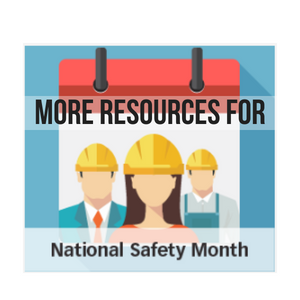What is the most hazardous task your workers will do today? If you’re in a high-hazard industry, you might think it’s operating a dangerous piece of machinery or working at heights. If your industry is less dangerous, maybe it’s a job that requires heavy lifting. However, there’s a good chance that the most dangerous thing your workers will do today is none of the above. It’s very likely to be something more routine, an activity many people do every day without considering the hazards. That activity, of course, is driving.

Week 4 of National Safety Month, sponsored by the National Safety Council, focuses on safe driving, both on and off the job.
Driving is so ingrained in our daily routines that many of us are desensitized to its hazards. But think of it this way: driving a car means operating a machine that weighs thousands of pounds, often at speeds exceeding 60 miles per hour, while navigating busy streets and highways full of other cars, buses, trucks, pedestrians, cyclists, changing road conditions, weather hazards, and more. And if that’s not enough, many people try to do all this while simultaneously texting, distracted by passengers, fatigued, under the influence of drugs or alcohol—or all of the above.
It’s no wonder, then, that traffic incidents are consistently the number-one cause of workplace fatalities and the number-two cause of unintentional injury deaths in the United States.
You may be wondering what an employer can do about this issue. Unless your employees are commercial drivers or frequently drive company vehicles, you might think employers have a limited role in making sure their workers drive safely.
But whether your workers drive only during their commutes or have driving responsibilities on the job, providing a refresher on safe driving practices can help prevent injuries and fatalities and the associated lost time and productivity, insurance claims, property damage, and more.
Safer Cars?
Automakers include an ever-increasing lineup of features intended to improve safety and intervene when drivers err, from electronic stability control and automatic emergency braking to blind spot warnings and backup cameras. Many of these feature are genuinely useful, but the NSC warns that there is still no replacement for an alert, vigilant, cautious driver behind the wheel. The NSC encourages drivers to take advantage of the safety features their vehicles offer; however, it is crucial to understand the uses and limitations of those features and avoid overrelying on them. The NSC offers the following advice:
- Make sure you understand your vehicle’s safety features before using them by consulting the vehicle manual.
- Maintain your vehicle to keep safety features working correctly, including by clearing the vehicle of mud, ice, and snow.
- Pay attention to vehicle alerts and warnings.
Safe Driving Essentials
Share these safe driving tips from OSHA with your employees as an important reminder to respect the hazards of operating a vehicle:
- Always wear a seat belt, and make sure that all passengers do, as well.
- Do not drive if you are under the influence of alcohol or drugs. Call a cab or take public transportation instead.
- Check any medications you take for side effects, such as drowsiness, that could impair your driving, and avoid taking those medications before you drive.
- Avoid driving while drowsy or fatigued. If you feel sleepy behind the wheel, pull over and take a break.
- Set realistic goals for the number of miles you can drive safely each day, and take periodic breaks to get out of the vehicle, stretch, and take a walk.
- Avoid distractions such as texting or using mobile devices while driving, manipulating GPS or in-car entertainment systems, and anything else that takes your eyes off the road, your mind off your task, or your hands off the steering wheel.
- Secure any tools or equipment before starting the vehicle to prevent them from becoming a hazard during a sudden stop or crash.
- Don’t respond to aggressive driving; avoid engaging in conflict with other drivers and be patient and courteous in traffic. If you encounter a seriously aggressive driver who poses a public safety hazard, call the police.
- Slow down in work zones and pay attention to changes in the traffic pattern. Watch for workers throughout the work zone.
- Keep your vehicle in safe operating condition; follow your manufacturer’s maintenance schedule and inspect your vehicle for safety issues before you drive.
- Use extra caution and reduce your speed at night, during challenging weather conditions like snow and ice, and on roads that are narrow or have poor visibility.
- Constantly scan the road ahead of you for hazards, including disabled vehicles, pedestrians or cyclists, animals or debris in the roadway, and drivers who may be impaired.
More Information
For more information on safe driving, refer to the following resources from Safety.BLR.com®:
- Feds report concerning uptick in highway fatalities
- Toolbox talk: Cell phone safety while driving
- Toolbox talk: Driving defensively
- Poster: Put an End to Distracted Driving
Not a Safety.BLR.com subscriber? Visit the site today and take advantage of all that it has to offer!

